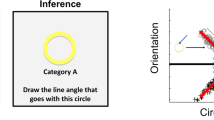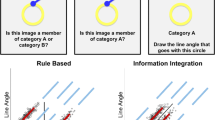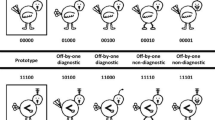Abstract
Categorization decisions are made thousands of times every day, and a typical adult knows tens of thousands of categories. It is thus relatively rare that adults learn new categories without somehow reorganizing pre-existing knowledge. Yet, most perceptual categorization research has investigated the ability to learn new categories without considering they relation to existing knowledge. In this article, we test the ability of young adults to merge already known categories into new categories as a function of training methodology and category structures using two experiments. Experiment 1 tests participants’ ability to merge rule-based or information-integration categories that are either contiguous, semi-contiguous, or non-contiguous in perceptual space using a classification paradigm. Experiment 2 is similar Experiment 1 but uses a YES/NO learning paradigm instead. The results of both experiments suggest a strong effect of the contiguity of the merged categories in perceptual space that depends on the type of category representation that is learned. The type of category representation that is learned, in turn, depends on a complex interaction of the category structures and training task. We conclude by discussing the relevance of these results for categorization outside the laboratory.










Similar content being viewed by others
Notes
The noise distribution was cut so that the mixture parameters could not be negative and summed to 1.
On any given trial, participants chose one of two response buttons so chance performance was 0.50, and each block had 96 trials.
References
Aerts, D., Gabora, L., & Sozzo, S. (2013). Concepts and their dynamics: A quantum-theoretic modeling of human thought. Topics in Cognitive Sciences, 5, 737–772.
Ashby, F., & Maddox, W. T. (1993). Relations between prototype, exemplar, and decision bound models of categorization. Journal of Mathematical Psychology37, 372–400. http://homepage.psy.utexas.edu/homepage/group/maddoxlab/Publications/1990-1994/relations.pdf
Ashby, F. G., Alfonso-Reese, L. A., Turken, A. U., & Waldron, E. M. (1998). A neuropsychological theory of multiple systems in category learning. Psychological Review, 105(3), 442.
Ashby, F. G., & Ell, S. W. (2001). The neurobiology of human category learning. Trends in Cognitive Science, 5, 204–210.
Ashby, F. G., & Gott, R. E. (1988). Decision rules in the perception and categorization of multidimensional stimuli. Journal of Experimental Psychology: Learning, Memory, and Cognition, 14, 33–53.
Ashby, F. G., & Maddox, W. T. (2010). Human category learning 2.0. Annals of the New York Academy of Sciences, 1224, 147–161.
Badre, D., Kayser, A. S., & D’Esposito, M. (2010). Frontal cortex and the discovery of abstract action rules. Neuron, 66, 315–326.
Bishop, C. (2006). Pattern recognition and machine learning. Singapore: Springer.
Brainard, D. H. (1997). The psychophysics toolbox. Spatial Vision, 10, 433–436.
Cohen, B., & Murphy, G. L. (1984). Models of concepts. Cognitive Science, 8, 27–58.
Ell, S. W., Smith, D. B., Peralta, G., & Hélie, S. (2017). The impact of category structure and training methodology on learning and generalizing within-category representations. Attention, Perception, & Psychophysics, 79, 1777–1794.
Erev, I. (1998). Signal detection by human observers: A cutoff reinforcement learning model of categorization and decisions under uncertainty. Psychological Review, 105, 280–298.
Erickson, M. A. (2008). Executive attention and task switching in category learning: Evidence for stimulus-dependent representation. Memory & Cognition, 36(4), 749–761. https://doi.org/10.3758/MC.36.4.749.
Erickson, M. A., & Kruschke, J. K. (1998). Rules and exemplars in category learning. Journal of Experimental Psychology: General, 127(2), 107.
Feldman, J. (2003). A catalog of Boolean concepts. Journal of Mathematical Psychology, 47, 75–89.
Fodor, J. A., & Pylyshyn, Z. W. (1988). Connectionism and cognitive architecture: A critical analysis. Cognition, 28, 3–71.
Heckler, A. F. (2011). The ubiquitous patterns of incorrect answers to science questions: The role of automatic, bottom-up processes. The Psychology of Learning and Motivation, 55, 227–267.
Hélie, S., & Ashby, F. G. (2012). Learning and transfer of category knowledge in an indirect categorization task. Psychological Research, 76, 292–303.
Hélie, S., Roeder, J. L., & Ashby, F. G. (2010). Evidence for cortical automaticity in rule-based categorization. Journal of Neuroscience, 30(42), 14225–14234. https://doi.org/10.1523/JNEUROSCI.2393-10.2010.
Hélie, S., Shamloo, F., & Ell, S. W. (2017). The effect of training methodology on knowledge representation in categorization. PLoS ONE, 12, e0183904.
Hélie, S., Waldschmidt, J. G., & Ashby, F. G. (2010). Automaticity in rule-based and information-integration categorization. Attention, Perception, & Psychophysics, 72(4), 1013–1031.
Levering, K. R., & Kurtz, K. J. (2015). Observation versus classification in supervised category learning. Memory & Cognition43(2), 266–282. http://www.ncbi.nlm.nih.gov/pubmed/25190494 https://doi.org/10.3758/s13421-014-0458-2
Ling Wu, L., & Barsalou, L. W. (2009). Perceptual simulation in conceptual combination: Evidence from property generation. Acta Psychologica 132(2), 173–189. http://www.sciencedirect.com/science/article/pii/S0001691809000183 (Spatial working memory and imagery: From eye movements to grounded cognition) https://doi.org/10.1016/j.actpsy.2009.02.002
Markman, A. B. (2002). Stimulus categorization. In D. L. Pashler & H. Medin (Eds.), Stevens’ handbook of experimental psychology (3rd ed., Vol. 2, pp. 165–208)., Memory and cognitive processes New York: Wiley.
Markman, A. B., & Ross, B. (2003). Category use and category learning. Psychological Bulletin, 129, 529–613.
Medin, D. L., & Schaffer, M. M. (1978). Context theory of classification learning. Psychological Review, 85(3), 207–238.
Miles, S. J., & Minda, J. P. (2011). The effects of concurrent verbal and visual tasks on category learning. Journal of Experimental Psychology: Learning, Memory, and Cognition, 37(3), 588–607. https://doi.org/10.1037/a0022309.
Nosofsky, R. M. (1986). Attention, similarity, and the identification-categorization relationship. Journal of Experimental Psychology: General, 115, 39–57.
Posner, M. I., & Keele, S. W. (1968). On the genesis of abstract ideas. Journal of Experimental Psychology, 77, 353–363.
Prinz, J. J. (2012). Regaining composure: A defense of prototype compositionality. In M. Werning, W. Hinzen, & E. Machery (Eds.), The oxford handbook of compositionality (pp. 437–453). New York: Oxford University Press.
Reed, S. K. (1972). Pattern recognition and categorization. Cognitive Psychology, 3, 382–407.
Seger, C. A., & Miller, E. K. (2010). Category learning in the brain. Annual Review of Neuroscience, 33, 203–219.
Shepard, R. N., Hovland, C. I., & Jenkins, H. M. (1961). Learning and memorization of classifications. Psychological Monographs: General and Applied, 75, 1–42.
Smith, E. E., Osherson, D. N., Rips, L. J., & Keane, M. (1988). Combining prototypes: A selective modification model. Cognitive Science, 12, 485–527.
Smith, J. D., & Minda, J. P. (2002). Distinguishing prototype-based and exemplar-based processes in dot-pattern category learning. Journal of Experimental Psychology: Learning, Memory, & Cognition, 28, 800–811.
Treisman, M., & Williams, T. C. (1984). A theory of criterion setting with an application to sequential dependencies. Psychological Review, 91, 68–111.
Voorspoels, W., Storms, G., & Vanpaemel, W. (2012). An exemplar approach to conceptual combination. Psychologica Belgica, 52, 435–458.
Waldschmidt, J. G., & Ashby, F. G. (2011). Cortical and striatal contributions to automaticity in information-integration categorization. Neuroimage, 56(3), 1791–1802.
Wisniewski, E. J. (1997). When concepts combine. Psychonomic Bulletin & Review, 4, 167–183.
Zadeh, L. A. (1982). A note on prototype theory and fuzzy sets. Cognition, 12, 291–297.
Zeithamova, D., Maddox, W. T., & Schnyer, D. D. M. (2008). Dissociable prototype learning systems: Evidence from brain imaging and behavior. Journal of Neuroscience28(49),13194–13201. http://www.pubmedcentral.nih.gov/articlerender.fcgi?artid=2605650&tool=pmcentrez&rendertype=abstract http://www.jneurosci.org/content/28/49/13194.short https://doi.org/10.1523/JNEUROSCI.2915-08.2008
Acknowledgements
This research was supported in part by NSF grants #1349677-BCS and #1349737 to SH and SWE (respectively).
Author information
Authors and Affiliations
Corresponding author
Ethics declarations
Conflicts of interest
The authors declare that they have no conflict of interest.
Human participants
All procedures performed in studies involving human participants were in accordance with the ethical standards of the institutional and/or national research committee and with the 1964 Helsinki declaration and its later amendments or comparable ethical standards.
Informed consent
Informed consent was obtained from all individual participants included in the study.
Rights and permissions
About this article
Cite this article
Hélie, S., Shamloo, F. & Ell, S.W. The impact of training methodology and category structure on the formation of new categories from existing knowledge. Psychological Research 84, 990–1005 (2020). https://doi.org/10.1007/s00426-018-1115-3
Received:
Accepted:
Published:
Issue Date:
DOI: https://doi.org/10.1007/s00426-018-1115-3




